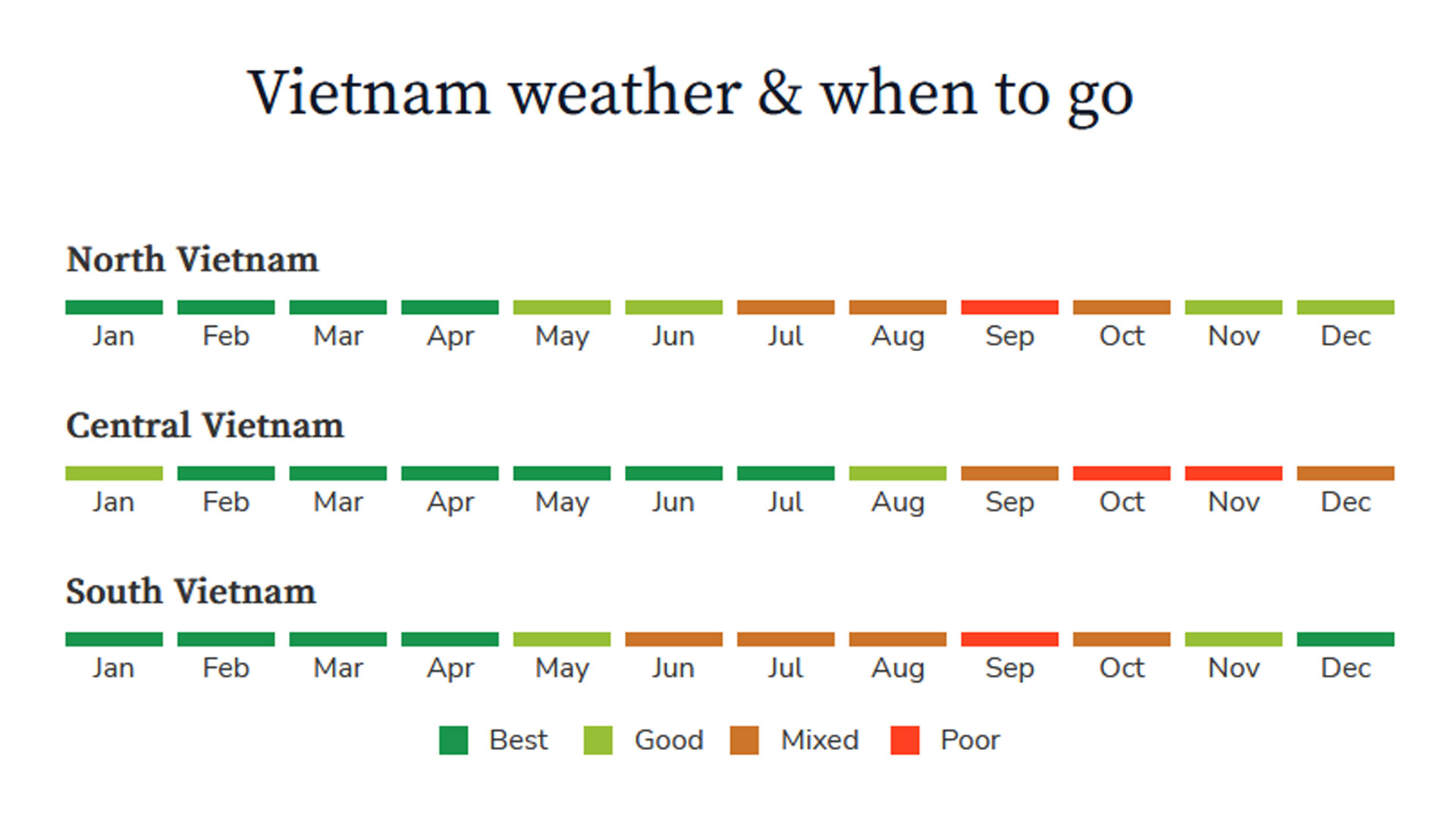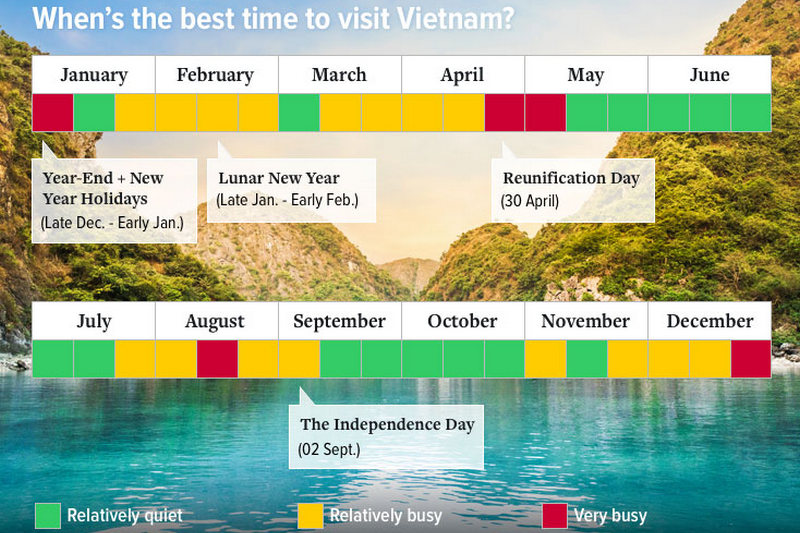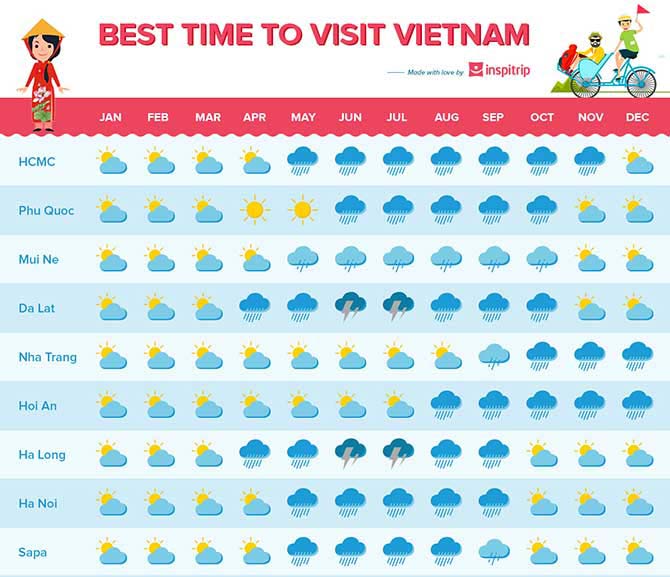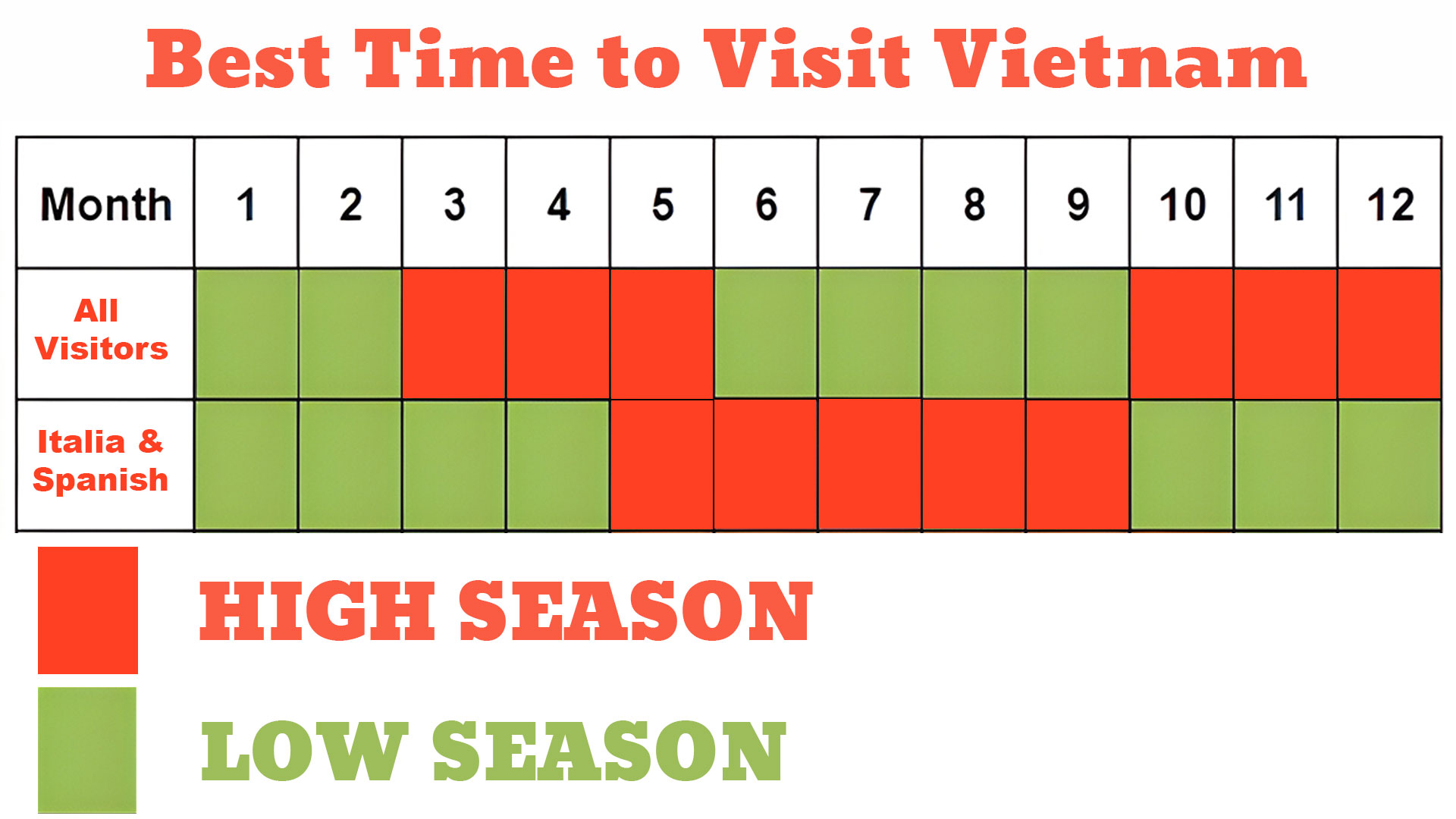Best Vietnam Seasons: A Complete Guide for Travelers
Vietnam is a beautiful country that boasts a diverse climate, which means there is never a bad time to visit. However, understanding the best seasons to travel to Vietnam can make your experience even more enjoyable. In this guide, we’ll explore the best seasons to visit Vietnam, breaking down the weather by month and sharing tips to help you make the most of your trip. Whether you’re looking for warm beaches, scenic mountains, or vibrant cities, Vietnam has something to offer all year round.

Understanding Vietnam’s Climate
Vietnam’s geography influences its weather significantly. The country stretches over 1,000 miles from north to south, leading to different climates in the north, central, and southern regions.
-
Northern Vietnam has a temperate climate with distinct seasons: spring, summer, fall, and winter. It can get chilly in the winter months, while summers can be hot and humid.
-
Central Vietnam experiences a tropical climate with two distinct seasons: the rainy season and the dry season. This region is a bit hotter, especially during the summer months.
-
Southern Vietnam enjoys a tropical monsoon climate, with wet and dry seasons. The weather here remains warm and humid year-round.
The Best Time to Visit Northern Vietnam
The best season to visit Northern Vietnam is from October to April. During this time, the weather is generally cooler and more pleasant, making it ideal for sightseeing and outdoor activities. The temperatures range from 15°C (59°F) to 25°C (77°F), perfect for exploring cities like Hanoi and the stunning Halong Bay.
Key Events in Northern Vietnam:
-
Tet Festival (Lunar New Year): January or February is a major cultural event in Vietnam, celebrated with vibrant festivals, parades, and family gatherings.
-
Autumn (September-November): This season is considered the most picturesque, especially in Hanoi, where the city is covered in golden-yellow leaves.

Top Places to Visit in Northern Vietnam:
-
Hanoi: The capital city offers rich history, vibrant street food culture, and stunning colonial architecture.
-
Halong Bay: A UNESCO World Heritage site famous for its limestone islands and crystal-clear waters.
-
Sapa: Explore the breathtaking terraced rice fields and meet local ethnic minority groups.
The Best Time to Visit Central Vietnam
Central Vietnam’s weather can be a bit unpredictable due to its tropical climate. However, the best time to visit is February to August, when the region enjoys dry and sunny weather. The temperature ranges from 25°C (77°F) to 35°C (95°F), ideal for beach activities and outdoor exploration.
Key Events in Central Vietnam:
-
Hue Festival (April or May): This biennial festival celebrates Vietnam’s royal history with cultural performances, processions, and traditional food.
-
Hoi An Lantern Festival (every full moon): A beautiful sight in the historic town of Hoi An where colorful lanterns light up the streets.
Top Places to Visit in Central Vietnam:
-
Hue: Visit the Imperial City, the former capital of Vietnam, to see ancient palaces and temples.
-
Hoi An: A charming town known for its well-preserved architecture, ancient temples, and delicious cuisine.
-
Da Nang: Enjoy stunning beaches like My Khe and visit the Marble Mountains.

The Best Time to Visit Southern Vietnam
Southern Vietnam, particularly Ho Chi Minh City (Saigon) and the Mekong Delta, is warm and humid year-round. However, the ideal time to visit is during the dry season, which runs from December to April. During this time, the temperatures range from 25°C (77°F) to 35°C (95°F), and rainfall is minimal, making it perfect for exploring the bustling cities and lush landscapes.
Key Events in Southern Vietnam:
-
Tet Festival: Celebrated in January or February, this is one of the most significant events in Vietnam, especially in the south, with fireworks, parades, and cultural performances.
-
Hochiminh City International Festival (December): A series of concerts and cultural events showcasing Vietnamese and international talent.
Top Places to Visit in Southern Vietnam:
-
Ho Chi Minh City: Explore the dynamic city with its vibrant street markets, colonial architecture, and museums.
-
Mekong Delta: Take a boat tour through the river system, visit floating markets, and discover the unique life of the southern countryside.
-
Phu Quoc Island: Relax on the beautiful beaches of this tropical island, known for its crystal-clear waters and luxurious resorts.

Seasonal Highlights and What to Expect
Peak Tourist Seasons
Vietnam experiences its peak tourism season during December to March, especially in the north and south. The weather is cooler, making it more comfortable for tourists to explore. This is the best time to visit famous destinations such as Hanoi, Halong Bay, Hoi An, and Ho Chi Minh City. However, be prepared for larger crowds and higher prices for accommodation and tours during this period.
Off-Peak Seasons
The off-peak season typically falls between May and September, when the weather is hotter and wetter, particularly in the central and southern regions. While it may be less crowded, it’s also the time when heavy rains can make sightseeing difficult. If you’re willing to travel during this period, you’ll find lower prices and fewer tourists.
Best Time for Specific Activities
-
Beach Lovers: The best time to visit Vietnam’s beaches is from December to April, especially in Phu Quoc, Mui Ne, and Nha Trang.
-
Trekking & Hiking: The cooler months from October to April are ideal for trekking in places like Sapa and Mai Chau, where temperatures are more comfortable for outdoor activities.
-
Cultural Festivals: The Tet Festival (Lunar New Year), celebrated across the country, is the most significant cultural event in Vietnam. However, keep in mind that many businesses close during this time, and transportation may be limited.
What to Pack for Vietnam
When preparing for your trip to Vietnam, it’s important to consider the weather conditions. Here’s a list of essentials to pack:
-
Light Clothing: Cotton shirts, shorts, and dresses for the hot, humid climate.
-
Rain Gear: If traveling during the wet season (May to September), bring a rain jacket or umbrella.
-
Comfortable Shoes: You’ll be walking a lot, so pack sturdy, comfortable shoes for exploring cities and trekking.
-
Sunscreen and Hat: Protect yourself from the strong UV rays, especially if you’re heading to the beach.
Frequently Asked Questions
1. What is the best time to visit Vietnam for sightseeing?
The best time to visit Vietnam for sightseeing is from October to April, when the weather is cooler and more comfortable. This is perfect for exploring the historical sites and natural wonders.
2. Is it safe to travel to Vietnam during the rainy season?
Yes, it is safe to travel to Vietnam during the rainy season, but you may face heavy rains and occasional floods. It’s a good idea to check the weather forecast and plan your activities accordingly.
3. When is the best time to visit Vietnam’s beaches?
The best time to visit Vietnam’s beaches is from December to April, when the weather is dry and sunny, making it perfect for swimming and relaxing on the beach.
4. Are there any cultural festivals in Vietnam?
Yes, Vietnam has many cultural festivals, with the Tet Festival (Lunar New Year) being the most famous. It takes place between January and February, and it’s a great time to experience the local traditions and celebrations.
Conclusion
No matter when you visit, Vietnam offers an unforgettable experience for every type of traveler. Whether you’re enjoying the vibrant culture of the cities, relaxing on beautiful beaches, or exploring the lush countryside, understanding the different seasons will help you make the most of your trip. From the cool and scenic north to the warm and lively south, Vietnam’s weather offers something for everyone. So, plan accordingly, pack smart, and enjoy the best Vietnam has to offer!


